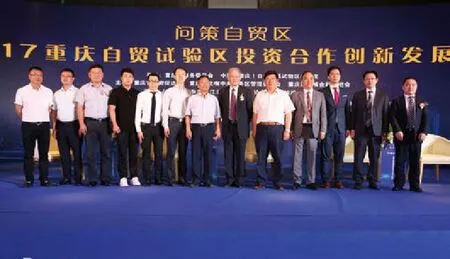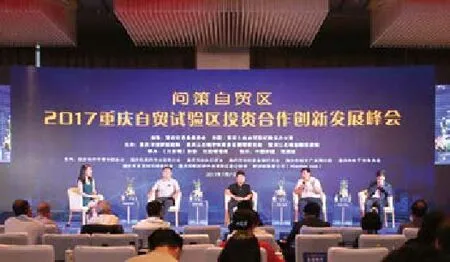“问策自贸区”2017重庆自贸试验区投资合作创新发展峰会在渝召开
2017-08-22曾睿
□ 文/本刊记者 曾睿
“问策自贸区”2017重庆自贸试验区投资合作创新发展峰会在渝召开
□ 文/本刊记者 曾睿

复旦大学经济学院党委副书记、上海自贸区综合研究院秘书长尹晨(左六),长江学者、重庆大学著名经济学教授姚树洁(左七),新加坡前驻美国大使馆参赞郭成惠(左八)等演讲嘉宾与与会的国内外专家学者合影。
重庆自贸试验区自挂牌以来,其未来发展受到外界高度关注。7月7日下午,2017重庆自贸试验区投资合作创新发展峰会在重庆江北嘴中央商务区举行。本次峰会由重庆市商务委员会、中国(重庆)自由贸易试验区办公室指导,重庆市投资促进局、重庆江北嘴中央商务区管理委员会、重庆江北嘴金融促进会联合主办。旨在为搭建探讨重庆自贸试验区发展的交流阵地,推动试验区更好更快地成熟与发展。
新加坡前驻美国大使馆参赞郭成惠,复旦大学经济学院党委副书记、上海自贸试验区综合研究院秘书长尹晨,以及重庆市商务委员会、中国(重庆)自由贸易试验区办公室相关负责人和试验区内多家企业负责人在“问策自贸区”主题下充分发表了各自的观点。
新加坡前驻美国大使馆参赞郭成惠认为,随着中新(重庆)合作项目的日益推进,新加坡与重庆和西部地区的联系将更加紧密。而新加坡作为率先推动国际自由贸易的先行对口合作国,将有利促进重庆自贸试验区与新加坡在资金、人才、信息上的互联互通。另一方面,重庆的产业优势非常明显,汽车产业就是个很好的例子。而且在自贸试验区范围内,跨境电商等现代服务业也能发挥更大的作用。重庆应该让更多外商了解自贸试验区的发展情况和自身的各种优势,促进招商引资,避免这些可贵的优势养在深闺人不识。重庆现在的GDP和人均收入都在快速增长,已经成为西部地区开发开放的桥头堡。因此,重庆如果能将自身的区位优势充分发挥,就能在很大程度上促进整个西部地区的进一步互联互通和对外开放。他还认为重庆自贸试验区应该加强对外的宣传,提高品牌知名度。

2017重庆自贸试验区投资合作创新发展峰会现场。
复旦大学经济学院党委副书记、上海自贸区综合研究院秘书长尹晨在发言中表示,目前获批成立的11个自由贸易试验区的共同任务是要服务于中国新一轮对外开放的大战略。在双向开放的新格局下,重庆自贸试验区除了要复制和借鉴以上海为代表的自贸区的制度框架之外,更加重要的在于要充分用足负面清单政策。今年6月,国务院办公厅发布了《关于印发自由贸易试验区外商投资准入特别管理措施(负面清单)(2017年版)的通知》。与上一版相比,新版负面清单减少了10个条目、27项措施。在27项减少的措施中,制造业有10项措施,信息技术服务、金融、租赁和商务服务3个行业有9项措施。服务业扩大开放的态势已经十分明显,在旅游、文化、医疗健康、金融服务等行业,重庆应该抓住这次开放的机遇。重庆自贸试验区应进一步巩固产业经济与城市功能,将重庆建设成为全球价值链的重要环节。
“将重庆自贸试验区与重庆在‘一带一路’与长江经济带背景中联系考虑。”长江学者、重庆大学著名经济学教授姚树洁认为,重庆将成为长江黄金水道上的经济制高点。中国在不断地积极扩大开放、寻求新发展机遇。中国经济在改革开放之后,已经取得了世人瞩目的成就,形成了以长三角、珠三角、京津冀为代表的城市集群。以现在的态势来看,成渝城市群很有可能会成为中国经济发展的第四极。在这个背景之下,重庆自贸试验区的建设不仅要克服其他自贸试验区所面临的困境,还应有所创新和特色,从制度统一,到产业集聚和发展,再到联合成渝城市群,打破壁垒,通过规模化与集聚化,成为长江黄金水道上游制高点。
重庆市商务委自贸办制度创新处处长张葵在发言中表示,重庆自贸试验区的发展仍处于摸索阶段,随着重庆自贸试验区的对外开放程度越来越高,越来越多的企业将汇聚在重庆,将带动重庆开放发展。
作为西部的桥头堡城市,重庆经济的发展对整个西部地区的发展起着至关重要的作用。重庆自贸试验区的未来发展不仅需要对标新加坡等发达国家的经验,还需要结合国内情况,以上海自贸试验区的发展经验为蓝本,结合本地产业经贸特点综合创新发展。
“一带一路”和长江经济带的漫长贯通的线路上,沪渝总是醒目的两点,上海向东,重庆向西,两者之间却牢牢地连着长江,两地互动,自然靠着这条黄金水道。港务物流集团所属寸滩港区,长江上游最大集装箱枢纽港;所属果园港区是中国内河规划建设最大的水、铁、公联运港,是“一带一路”和长江经济带的重要节点。“重庆目前有4个国家一类口岸,其中有3个在重庆自贸试验区范围内。凭借其强大的水港功能区有利条件,不断展现其外贸港的巨大优势。重庆自贸试验区应充分发挥各类功能性口岸功能,完善体系,以自贸试验区为契机大力发展重庆口岸经济。”重庆港务物流集团有限公司副总经理黄继表示。
交通银行、重庆国际经济技术合作集团、重庆钢铁集团、第一太平戴维斯等企业或机构的相关负责人也在峰会上发表了对重庆自贸试验区未来发展的建议。
(图片由《江北嘴》杂志提供)

Since the opening of Chongqing Pilot Free Trade Zone, its future development received high attention from the outside world. Afternoon of July 7 witnessed the opening of 2017 Investment Cooperation, Innovation and Development Summit of Chongqing Pilot Free Trade Zone in Chongqing Jiangbeizui CBD. This summit was guided by Chongqing Commerce Commission, Office of China (Chongqing) Pilot Free Trade Zone, and jointly organized by Chongqing Investment Promotion Bureau, Chongqing Jiangbeizui Central Business District Management Committee, and Chongqing Jiangbeizui Financial Promotion Association. It aimed to set up an exchange position to explore the development of Chongqing Pilot Free Trade Zone and promote the better and faster maturity and development of the Chongqing Free Trade Zone. Peter Kuok, Counselor of Embassy of Singapore in the United States, Yin Chen, Deputy Secretary of institute of economics in Fudan University and secretary general of the Synthetic Study Institute of Shanghai Free Trade Zone and related person in charge of Chongqing Commerce Commission, Office of China (Chongqing) Pilot Free Trade Zone, and a number of business executives in Chongqing Pilot Free Trade Zone fully expressed their views under the theme of“Strategies about Free Trade Zone”.
Peter Kuok, Counselor of Embassy of Singapore in the United States considered that with the development of China (Chongqing)-Singapore cooperative project, Singapore will be more closely linked with Chongqing and the West. Singapore, as a leading partner in promoting international free trade, will facilitate the interconnection between Chongqing free trade zone and Singapore in terms of capital, personnel and information. On the other hand, the industrial advantage of Chongqing is very obvious, and the automobile industry is a good example. Moreover, in the Pilot Free Trade Zone, cross-border online retailers and other modern service industry can play a greater role. Chongqing should let more foreigners to understand various advantages of development of the Pilot Free Trade Zone and the promotion of investment, to avoid these valuable advantages kept in unknown. Chongqing's GDP and per capita income are growing rapidly, and it has become the bridgehead for the development and opening of the western region. Therefore, if Chongqing can give full play to its own regional advantages, it can greatly promote the further interconnectivity and opening-up of the whole western region. He also believed that Chongqing Pilot Free Trade Zone should strengthen external publicity and improve brand awareness.Yin Chen, Deputy Secretary of institute of economics in Fudan University and Secretary General of the Synthetic Study Institute of Shanghai Free Trade Zone, expresses in speech that at present, the common task of those 11 pilot free trade zones is to serve China's new round of opening up strategy. In the new pattern of two-way opening, Chongqing Pilot Free Trade Zone, in addition to copying and drawing on the framework of the free trade zone represented by Shanghai, should fully use the negative list policy. On June 2017, the general office of the State Council issued Special Administrative Measures of Pilot Free Trade Zone for Admittance of Foreign Investments (Negative List) (2017). Compared with the previous edition, the new version of the negative list decreased by 10 entries and 27 measures. In those 27 reductions, 10 measures were taken in the manufacturing sector, with 9 measures in the three sectors of information technology services, finance, leasing and business services. The service sector has opened wider to the outside world. In tourism, culture, health care, financial services and other industries, Chongqing should seize the opportunity of opening-up. The Chongqing free trade zone should further consolidate its industrial, economic and urban functions and build Chongqing into an important part of the global value chain.
After the jointed consideration of Chongqing Pilot Free Trade Zone, and Chongqing’s strategic location in “The Belt and Road” Initiative and Yangtze River Economic Zone, Yao Shujie, the Yangtze River Scholar and professor of economics, Chongqing University, considered that Chongqing will become the economic commanding point on the golden waterway of the Yangtze River. China is constantly actively opening wider and seeking new opportunities for development. After the reform and opening-up, China has made remarkable achievements in the world, forming a cluster of cities represented by the Yangtze River Delta, the Pearl River Delta and Beijing, Tianjin and Hebei. In view of the present situation, the Chengdu and Chongqing urban agglomeration will probably become the fourth pole of China's economic development. In this context, the construction of Chongqing Pilot Free Trade Zone should not only overcome dilemmas faced by other free trade zones but also has innovation and its characteristics. From system uni fi cation to industrial agglomeration and development, Chongqing should cooperate with Chengdu to form the urban agglomeration to break barriers to become a commanding point in the upper reaches of the Yangtze River by scale development and industry agglomeration.
Zhang Kui, Director of Department of institutional innovation, Chongqing Commerce Commission, expressed in his speech that, for Chongqing, the Pilot Free Trade Zone is still a new thing. At present, the development of Chongqing Pilot Free Trade Zone is still in the exploratory stage. With the level of opening up of Chongqing Pilot Free Trade Zone, more and more enterprises will converge on this land, which will lead to the rapid development of Chongqing's economy.
As a bridgehead in the west, the development of Chongqing's economy plays an important role in the development of the whole western region. The future development of Chongqing free trade zone requires not only the experience of developed countries such as Singapore, but also the domestic situation. Taking the development experience of the Shanghai free trade zone as a model, Chongqing Pilot Free Trade Zone should combine with the characteristics of local industry and trade to create a comprehensive innovation and development.
On the long lines of “The Belt and Road” Initiative and Yangtze River Economic Zone, Shanghai and Chongqing are always noticeable. Shanghai in the east of China and Chongqing in the west of China, these two cities are connected by the Yangtze River. The interaction between the two places naturally depends on the golden waterway. Cuntan Port Area belonged to Port Logistics Group represents the largest container hub port on the upper reaches of the Yangtze River; Guoyuan Port Area is the biggest combined transport port including the water carriage, railway transportation and road transport in inland river of China and also represents the major connection of “The Belt and Road” Initiative and Yangtze River Economic Zone. Chongqing currently has four national one-class ports, of which three in the Chongqing Pilot Free Trade Zone. With its powerful conditions in water port function area, Chongqing continues to show its great advantages in its foreign trade ports. Taking the free trade zone as an opportunity, Chongqing Pilot Free Trade Zone should give full play to various functionality of functional ports, improve the functional port system of Chongqing, and vigorously develop Chongqing port economy, said by Huang Ji, deputy general manager of Chongqing Port Logistics Group Co., Ltd.
Related principals of enterprises and institutions like Bank of Communications, Chongqing International Economic and Technological Cooperation Group, Chongqing Iron and Steel Group, Savills also announced their proposals for the future development of the Chongqing Pilot Free Trade Zone at the summit.
(Pictures are provided by Jiangbeizui Magazine )
“Strategies about Free Trade Zone”2017 Investment Cooperation, Innovation and Development Summit of Chongqing Pilot Free Trade Zone was Held in Chongqing
Article/Journalist Zeng Rui
